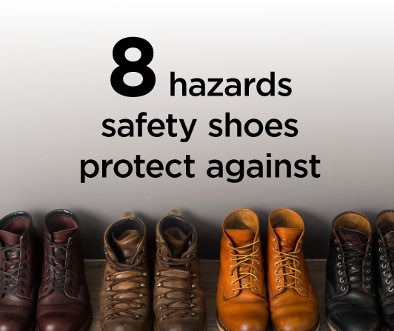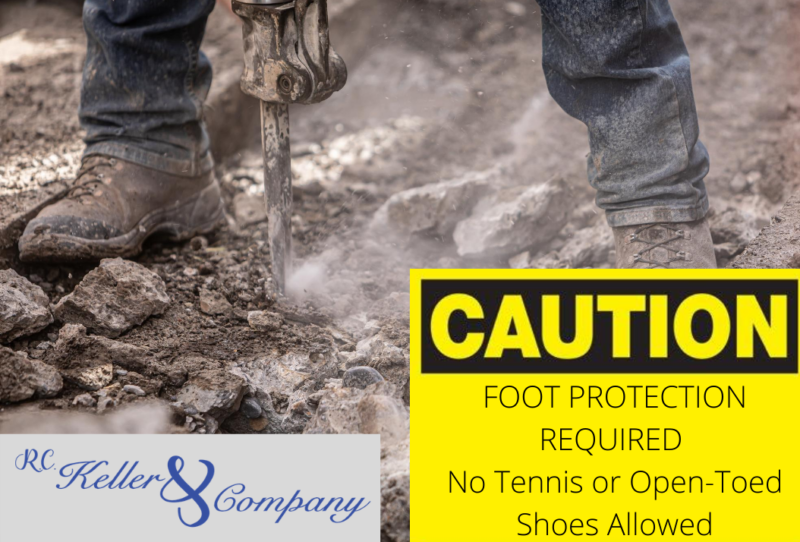When you think about shoes for the workplace, heavy-duty footwear such as steel toe boots may come to mind. These boots are important personal protective equipment (PPE) that many industrial and construction worksites require.
There are many kinds of shoes that can make jobs safer, though, not just steel toe boots. Other types of boots and shoes can provide traction, arch support and other safety benefits. To find the right foot protection for your job, you will need to do a hazard assessment and determine what kinds of risks, such as slipping and falling or sharp objects, pose a threat to the job. Once you determine this, you can select shoes or boots that offer the correct protection.
Shoes may not seem as critical to the workplace safety as protective eyewear or gloves, but footwear provide many benefits. If anyone in your workplace doubts the value of investing in footwear, offer him or her some of the ways safety shoes can keep workers safe.

Functions of Safety Shoes
When you have a foot injury, it can be debilitating and can result in time away from work or offer a difficulty in performing job duties. When you wear safety shoes or boots, they can help prevent many foot injuries in the following ways.
- Protect from falling and flying objects: When a worker carries heavy materials or work in dynamic environments where many people, machines and vehicles are operating at once, falling and flying objects are common hazards. Protective shoes like steel toe boots can effectively prevent crushing injuries to the feet.
- Protect from punctures: When a worker could step on a sharp object or could be struck by a sharp object from above, wearing a shoe with heavy-duty soles and thick materials surrounding the foot offer the best protection. At a construction site, for an example, many sharp objects could be in someone’s path. A soft-soled shoe might not provide enough protection.
- Protect from cutting hazards: Machinery that is sharp or contains moving parts can pose cutting hazards. Workers in the logging industry, for example, face dangers from chainsaws. If a chainsaw were to come in contact with a worker’s foot, the result could be catastrophic. Logging boots – which are required by OSHA under standard 29 CFR 1910.266 – made with cut-resistant material will protect those workers who use chainsaws. These boots are also waterproof or water repellant and support the ankles.
- Protect from electrical hazards: Electricity poses multiple risks in the workplace. Workers could face potential electric shocks or accumulate static electricity, which can lead to electric sparks in certain environments. To reduce chances of electrical accidents, non-conductive footwear made from leather, rubber or other materials that do not conduct electricity should be worn. In locations where the build-up of static on the body poses a hazard, anti-static or conductive footwear can be used. These options reduce the amount of static that accumulates on the body, preventing static electric sparks.
- Prevent slips, trips and falls: Slips, trips and falls can happen in any workplace and result in many accidents annually. Businesses can take steps such as implementing housekeeping measures and installing anti-slip floor tape to reduce the risks of these mishaps. Proper footwear can also provide additional protection against slips, trips and falls. Shoes with appropriate traction can help prevent falls on the same level in slippery environments. They can also prevent falls from ladders, which are all too common when people do not wear shoes with the proper treads. Wearing footwear that fit well and feel comfortable can also improve balance, which will help prevent slips, trips and falls.
- Prevent Fatigue: For the workers who stand all day, especially on a hard surface like concrete, fatigue can be a real problem. Muscles in the feet as well as the legs, back and other parts of the body grow tired and the situation can be worsened when an employee doesn’t wear the appropriate footwear. Shoes that provide adequate cushioning and arch support can make people more comfortable, which in turn alleviate strain on their muscles. This means an employee will grow fatigued less quickly. Employees who are less fatigued will be more alert, so they will likely do their jobs more safely and more efficiently. When you prevent muscle strain this will also help protect against musculoskeletal disorders such as chronic lower back pain.
- Prevent Burns: Burns from fire can happen in any workplace, but so can burns from chemicals and even from common workplace materials like cement. Footwear made from durable materials can prevent burns from chemical splashes, molten metal splashes and other dangerous substances that could injure the skin on the feet.
- Protect from extreme weather: We know cold weather can lead to injuries such as frost bite and hypothermia, these dangers should not be overlooked in the workplace. People who work outside in the winter are at risk, as well as employees who work in wet or refrigerated environments. The cold can exacerbate some less know workplace injuries. Raynaud’s Syndrome is a disease where the fingers can turn white from poor blood flow. This condition, related to vibration from power tool use, is made worse when the employees are exposed to cold temperatures. In some cases, this disorder can impact the feet as well, so keeping the feet warm and comfortable in conjunction with other measures for keeping the body warm is very important. Not all footwear is waterproof or insulated to provide protection against the cold, rain or snow, so be sure to select shoe options that are made from appropriate materials.
Don’t Forget the OSHA Regulations
As you can see, footwear for the workplace offers many kinds of protection for workers. For those reasons alone, it is worth making a foot protection program part of your workplace. You should also remember that in many work situations protective footwear is required.
OSHA standard 29 CFR 1910.136 states: The employer shall ensure that each affected employee uses protective footwear when working in areas where there is a danger of foot injuries due to falling or rolling objects, or objects piercing the sole, or when the use of protective footwear will protect the affected employee from an electrical hazard, such as a static-discharge or electric-shock hazard, that remains after the employer takes other necessary protective measures.
You should make sure your business follows the requirements and selects the appropriate safety shoes. Doing so will improve safety and comfort, which will make your employees happy too.

R.C. Keller & Company is a family owned independent insurance agency that has been serving the Schaumburg community and surrounding areas since 1910. We have helped the community with their home, auto, business and life insurance; if you have questions or are looking for a free review of your current insurance plan please give us a call at 847-907-4520 or send us an email.
